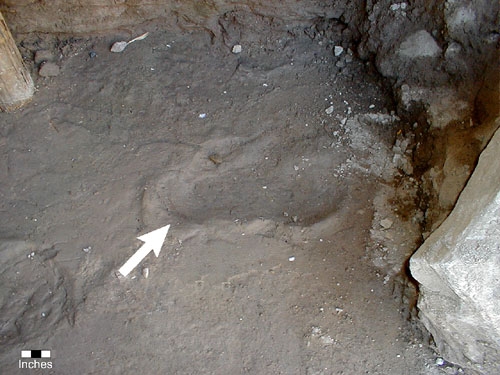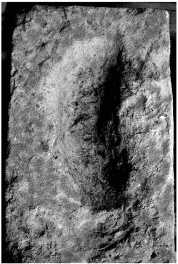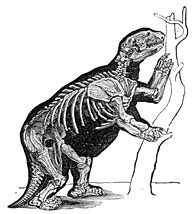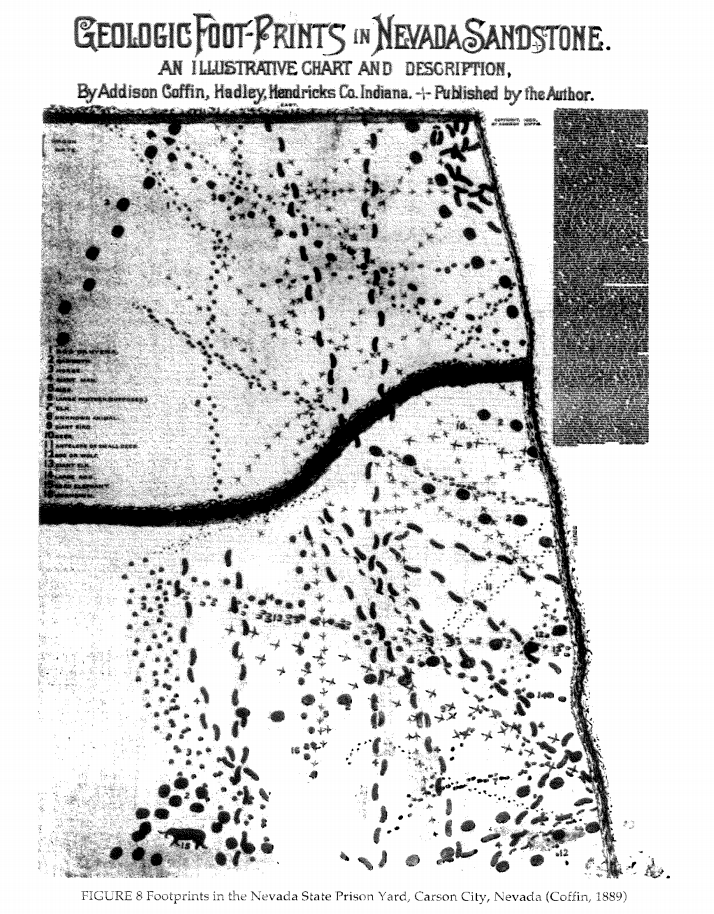|
The Fossil Evidence |
||
| Carson
City, Nevada "Giant Tracks" © 2006, Glen J. Kuban (Draft) Part of Kuban's Paluxy web site
During sandstone quarrying operations in the
late 1870's on the grounds of Nevada State Prison,
in Carson City, a variety of animal tracks were
found, including those of mammoth, bison, horse,
deer, wolf, birds, as well as some large oblong
tracks of uncertain origin. In 1882, sheriff W. J.
Hanks of Storey County brought the find to the
attention of H. W. Harkness of the California
Academy of Sciences in San Francisco. Harkness
identified the track beds as late Pliocene in age
(approx. 2 million years old) and interpreted the
problematic tracks as giant human footprints (Davis,
1912). Other geologists identified the prints as
being near the Pliocene-Quaternary border, which
would place them at about 1.6 million years by
conventional geology, although Stock (1936) implied
an age of only 50,000 years.
The prints in question were approximately 18 to 21 inches long and 8 to 9 inches wide. Though bearing a superficial resemblance to human prints, the tracks lacked obvious digit impressions and normal heel-ball-arch bottom contours typically found in human prints--features that Harkness explained by suggesting the giant trackmaker might have worn sandals. However, besides the enormous size and lack of distinct human features, the tracks also showed an unusual gait pattern, with a wide trackway gauge of 18 to 19 inches but very short average pace length (for the size of the prints) of only about 2 and a half feet. Within a year other scientists who studied the prints (LeConte, 1882, Davidson, 1883; Marsh, 1883) attributed them to a giant ground sloth named Mylodon, whose bones were found among other late-Pliocene to early Quaternary fossils in the same quarry. Further analysis was conducted by Chester Stock (1917, 1920, 1926) of the University of California, who carefully reconstructed a giant sloth foot and matched its imprint with the details exhibited by the prison tracks, confirming LeConte's earlier conclusion, and settling the matter even to the satisfaction of most earlier "giant track" advocates. Evidently giant ground sloths walked (or perhaps waddled is a better word) with weight on the outside of their feet, with the sole facing inward, and the claws pointing somewhat upward. This, along with the evidently soft nature of the mud when the prints were originally made, explained the lack of claw marks in the oblong prints (Eaton, 2005). Their generally bipedal appearance could have been due to either sloths walking on their hind legs, or the overlap of any fore prints with the hind feet--a phenomena known for a number of other prehistoric and modern animals. For example, some trackways of sauropods ("brontosaur" type dinosaurs) show only rear prints, or primarily rear prints, even though it is highly unlikely that any sauropods traveled in a bipedal manner. However, there were indications of fore-foot prints on some of the problematic tracks, indicating that the trackmaker walked on all fours at least at times, --further ruling out a human trackmaker (Davidson, 1883). In recent years a few strict creationists (Ferrell, 2001; Jochmans, 1979) have attempted to re-encourage the human track interpetation. They emphasize the lack of claw marks and tail marks in the trails. However, they fail to mention the above explanations for the lack of claw marks, as well as the non-human gait patterns and evidence of fore prints. In regards to tail marks, the relatively short tails of ground sloths certainly would not touch during quadruped locomotion, and may not have touched while walking bipedally.
Mylodon,
a giant ground sloth
At any rate, virtually
all mainstream workers and even most creationists
have accepted the prints as probable giant ground
sloth tracks. It should be noted that even if the
prints were early humans or hominids, their size
would be more problematic than their age, since the
presence of hominoids in late Pliocene/early
Quaternary strata is not in conflict with mainstream
geology.
Some of the prints, along with photographs and diagrams of the quarry trackways, are housed at the W. M. Keck Earth Science and Mineral Museum at the University of Nevada, Reno. For those interested in further researching these tracks, a detailed bibliography has been compiled by the Nevada State Museum. |
||
References:
|
||
|
Ice
Age Nevada and Lake Lahontan
 Photo courtesy of Eugene M. Hattori. Giant
ground sloth's hind footprint preserved in a
layer of sandstone at the Nevada State Prison,
Carson City, Nevada. These tracks were exposed
by prisoners quarrying sandstone building
blocks in the prison yard during the 1880s.
These tracks were briefly re-exposed between
2004 and 2005. - See
more Here
Between about 25,000 and 11,000 years ago, Nevada's late ice age climate was much cooler and wetter than today. While glaciers only occupied mountain ranges, much of the vegetation was similar to that of today, although it was found in different settings. This interval represents the end of the Wisconsin Stage of North America's Pleistocene geologic period, and it is well represented by the Nevada's paleontology and geology. Instead of a literal ice age, in which land is covered by continental glaciers, the Great Basin's Ice Age was marked by increased precipitation and reduced evaporation, known as a "pluvial" climate. This increased stream flow and encouraged lake formation. The Great Basin received its name because rivers and streams that originate in the mountains drain into the basin and end in lakes or sinks within valley bottoms throughout the region. During the Ice Age, the Great Basin region supported two major late Pleistocene pluvial lakes: Lake Lahontan and Lake Bonneville. Lake Bonneville lay almost exclusively in western Utah, and only a small area in eastern Nevada, while Lake Lahontan was mainly restricted to western Nevada. Lake Lahontan reached a maximum depth of over 500 feet and covered over 8,610 square miles, with vast stretches of open water separated by mountain ranges. Open water encouraged wave formation and strong currents within the lake. Surrounding mountain ranges were carved by waves that formed caves and multiple terraces. Currents moved stones and boulders, forming massive spits and dikes. Four major river systems—The Walker, Carson, Truckee, and Humboldt, as well as numerous smaller drainages—fed Lake Lahontan. The geological evidence for Lake Lahontan is best represented by its last major rise and fall. After a multi-millennial interval of warm, dry conditions around 25,000 years ago, each major river system began to fill its terminal lake basin until it overflowed into neighboring basins. One by one, drainage basins filled with water that began spilling over a pass or through a cut. Eventually, these individual lakes coalesced into a single water body, Lake Lahontan. As water breached a lake basin's threshold, some stability was reached in that lake's level as the receiving basin filled. Lake terraces represent some of these major events. The nature of a region's climate is dynamic, and during the lake's 75,000-year history, there were a series of major lake stands or lake levels known collectively as Lake Lahontan. Similarly, prior to about 75,000 years ago, there were other unnamed lakes occupying the same area. The vegetation of the Great Basin was comprised of today's species, but plant communities occurred up to 1,000 feet lower in elevation than they do today. Las Vegas Valley's yucca, Joshua tree, creosote, and mesquite vegetation were preceded by an Ice Age juniper woodland interspersed with sagebrush. Pinyon pine forests were absent in northern and central parts of the state, and the compositions of some plant communities were unique to that time. For example, shadscale, a lower elevation desert shrub, grew within western juniper groves along the shore of Lake Lahontan within the Winnemucca Lake basin. Today, 2,000 or more feet and ten miles separate the two. Perhaps the most striking differences between this period and today are the Ice Age animals that roamed the landscape. Mammoths, giant ground sloths, camels, shrub oxen, horses, cheetahs, and other extinct mammals are known to have inhabited Nevada during this time. Sandstone deposits quarried at the Nevada State Prison in the nineteenth century yielded sets of animal tracks from Pleistocene mammoths or mastodons, giant ground sloths, camels, bison, and horses. Fossil bones of mammoths, horses, and camels were uncovered, along with an obsidian flake and a possible bone tool. At Tule Springs in the 1930s, apparent fire hearths were found within present day Floyd Lamb State Park, north of Las Vegas. This tantalizing evidence led to a major archaeological project that did yield evidence of the presence of people some 10,000 years ago, but the association of them with extinct fauna was not supported. A most curious paleontological discovery occurred at Gypsum Cave approximately thirty miles northeast of downtown Las Vegas. Prior to about 11,000 years ago, Gypsum Cave had served as an Ice Age latrine for giant ground sloths for thousands of years. The cave was packed with layers of ground sloth droppings. The toilet behavior of this nine-foot-long herbivore can be inferred from modern tree sloths who defecate only once or twice a week at the base of a tree, forming a sizeable dung pile. This may serve as a territorial marker. Gypsum Cave is also of interest because of the purported association between humans and the ground sloths, something that has also failed to be substantiated in recent excavations. The end of the Pleistocene era occurred with a warming and drying trend. Lake Lahontan separated into smaller and smaller basins, which were isolated by intervening mountain ranges. The last lake remnants can be seen in Walker and Pyramid lakes. Throughout its former basin, however, miles of ancient lake terraces tell of its former extent, and deep-water silts and clays lie beneath dusty playas. Curious tufa formations and fossil mollusk shells provide further evidence of the once mighty lake. Perhaps the best known living relic of Nevada's ice age is Pyramid Lake's unique cui-ui fish. Source: Ice Age Nevada and Lake Lahontan |
||
|
Geologic
foot-prints in Nevada sandstone:
An illustrative chart and description - 1889 Geologic foot-prints in Nevada sandstone: An illustrative chart and description – 1889 by Addison Coffin (Author) - AMAZON Papers:
|
||
 |
||
| FAIR USE NOTICE: This page contains copyrighted material the use of which has not been specifically authorized by the copyright owner. Pegasus Research Consortium distributes this material without profit to those who have expressed a prior interest in receiving the included information for research and educational purposes. We believe this constitutes a fair use of any such copyrighted material as provided for in 17 U.S.C § 107. If you wish to use copyrighted material from this site for purposes of your own that go beyond fair use, you must obtain permission from the copyright owner. | ||
|
|



